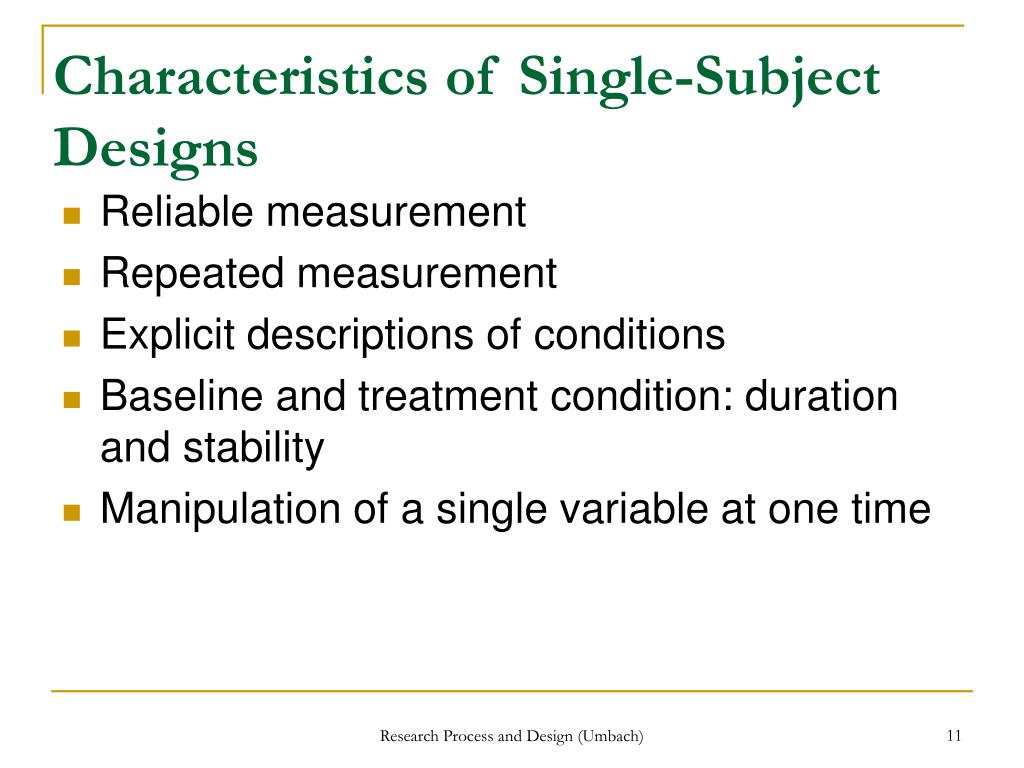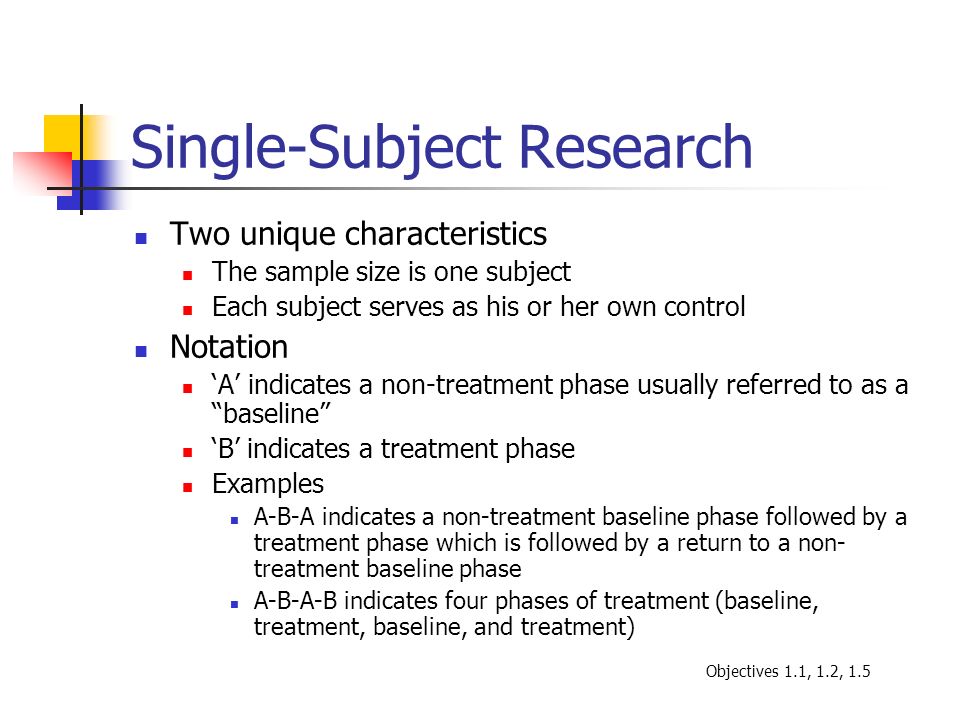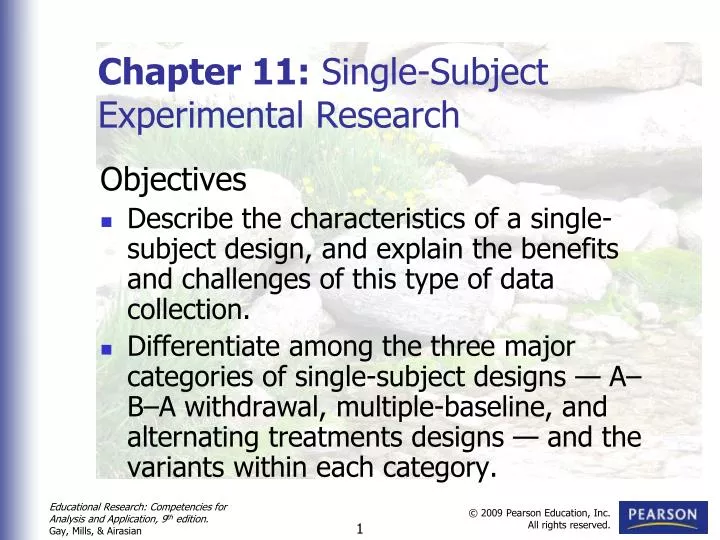In experiments you test the effect of an independent variable by creating conditions where different treatments eg. Trend An ascending or descending line.

Single Subject Design Ppt Download
The majority of this textbook is devoted to understanding group research which is the most common approach in psychology.

. Single subject research is a scientific research methodology that is increasingly used in the field of special education. Published on March 12 2021 by Pritha BhandariRevised on September 3 2021. Single-case SC studies have been identified by a variety of names including n of 1 studies and single-subject studies.
Explain the various phases characteristics and types of single subject design. This research design is useful when the researcher is attempting to change the behavior of an individual or a small group of individuals and wishes to document that change. Authors Shinpei Osaki 1.
The most basic single-subject research design is the. Here baseline levels of performance of an individual are compared with performance levels of that individual during intervention. Indeed interventions shown to be effective for a single individual may not be effective.
Benefits of Single Subject Design Study low incidence populations and behaviors Cost effective Evaluate intervention prior to large scale study Flexible design is adaptable to situation Can be conducted in practice settings Test clinical hypotheses Monitor progress in applied settings Limitations of Single Subject Design. This article reports the results of a study that located digitized and coded all 809 single-case designs appearing in 113 studies in the year 2008 in 21 journals in a variety of fields in psychology and education. Purpose of Single-SubjectSystem Designs Use it to monitor and evaluate participants responses to the interventions with which they address participants target problems.
A Single-subject Design Study Prog Rehabil Med. -AKA Single Case Design of Single Case Research. Single-Subject Methodology Single Subject Research Designs SSRDs work by designing an experiment where instead of a control group of subjects and an experimental group of subjects whose results are compared to one another the control and.
Research suggests that assertion training can be effective with a number of different types of clients in pursuit of a number. Characteristics of Single-SubjectSystem Designs. Dev Med Child Neurol.
It seems very easy to do when you read up on one design. It is essential for educators to understand the characteristics. But there are lots of things to consider and lots of things can go wrongIt requires quite a bit of training.
However in some cases researchers will use an alternative method called single-subject research design. The limitation most often cited in discussions of single-subject research designs is a lack of generality of obtained effects. This understanding will allow.
The strategy is to intensively study one participant system at a time Grinnell 1993. Investigating the Characteristics of Covert Unilateral Spatial Neglect Using the Modified Posner Task. A true experimental b AB design c ABAB design d ABA design.
It takes at least one three-credit course that you take over the whole semester. Therefore understanding the unique characteristics of single subject. Single case design is different than a case study -- a case study is more narrative and highlights things out of the norm.
In design of experiments single-subject curriculum or single-case research design SCED is a research design most often used in applied fields of psychology education and human behavior in which the subject serves as hisher own control rather than using another individualgroup. The term single-case study is preferred over the previously mentioned terms because previous terms suggest these studies include only one participant. Answer- Single-topic design or single-case research design is a research design that is used most often in the applied areas of psychology education and human behavior in which the subject is used to control its own rather than using another person group works.
A number of important studies dating back to the 1960s and 1970s investigated fluency treatments using SSED approaches eg Hanson 1978. This is the level of responding before any treatment is introduced and therefore the baseline phase is a kind of control condition. Of course single-subject research designs also have clear limitations that must be considered.
-single subject design is an experimental study and does not include just one subject usually 2 to 6 participants Introduction. Also called the ABA design. During the first phase A a is established for the dependent variable.
In a between-subjects design or a between-groups design every. You may have a greater risk of demand characteristics in a single-blind design compared to a double-blind design. Single-Case Reporting Guideline In BEhavioural Interventions SCRIBE Tate RL Perdices M Rosenkoetter U et al.
Recommendations for levels of evidence and quality rating. Single-subject research can be contrasted with group research which typically involves studying large numbers of participants and examining their behaviour primarily in terms of group means standard deviations and so on. Researchers use single-subject design because these designs are sensitive to individual.
Coded variables included the specific kind of design number of cases per study number of outcomes data points and phases per case and autocorrelations. 07-Engel-4581601-Papa-45411qxd 9272008 725 PM Page 209. Pre-experimental single subject design are also known as _____ and do not have adequate control for the factors that affect the internal validity of an experiment.
Single-case designs are uniquely suited for evaluating progress with individual clients. Single-blind and double-blind designs In a follow-up study you use a between-subjects single-blind design. Single subject research also known as single case experiments is popular in the fields of special education and counseling.
A placebo pill vs a new medication are applied. Haroldson Martin. CHAPTER 7 Single-Subject Design 209 Stable line A line that is relatively flat with little variability in the scores so that the scores fall in a narrow band.
Martin. Between-Subjects Design Examples Pros Cons. The use of single-subject experimental designs SSEDs has a rich history in communication sciences and disorders CSD research.
Cycle A pattern reflecting ups and downs d ep nig o tmf asur. Some participants are assigned to a control group while others are in a treatment group. The Single-Case Reporting guideline In BEhavioural interventions SCRIBE 2016 statement.
Single-subject design has its own tradition of methodology. Reed Godden 1977. Single-subject designs reflect the tenets of educational psychology that emphasise each students individualised learning needs and allow for simple methods of data collection and analysis Forbes et al Reference Forbes Ross and Chesser 2011Single-subject designs are primarily used to examine the existence of a causal or functional relationship.

Single Subject And Correlational Research Bring Schraw Et Al Ppt Download

Ppt Single Subject Research Design In A School System Powerpoint Presentation Id 726774

Ppt Experimental Research Designs Part 2 Powerpoint Presentation Free Download Id 315673

Quasi Experimental And Single Case Experimental Designs Ppt Download

Single Subject Experimental Research Ppt Video Online Download

Ppt Chapter 11 Single Subject Experimental Research Powerpoint Presentation Id 4529481

0 comments
Post a Comment